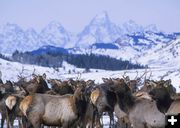

Feeding the elk
Elk at the Patrol Cabin feedground in the Gros Ventre drainage northeast of Jackson. Photo by Mark Gocke, WGFD.
|
|
Elk feeding begins in the Gros Ventre
by Wyoming Game & Fish
January 23, 2008
The Wyoming Game and Fish Department has begun feeding at the three state-operated elk feedgrounds in the Gros Ventre. The feedgrounds known as Fish Creek, Patrol Cabin and Alkali Creek feed as many as 3,000 wintering elk that are part of the Jackson elk herd.
Each winter, wildlife officials consider a variety of factors in deciding when it’s time to start feeding the elk. “We always look at how much forage is out there and how available it is due to snow levels, but ultimately it often comes down to elk distribution and behavior,” says Doug Brimeyer, Jackson Wildlife Biologist for the Wyoming Game & Fish Department. “We like to see the elk dispersed across their winter range, but when they start drifting down drainage in proximity to private land and livestock, we know we have to try to prevent that, which was the case this year.”
Most elk feedgrounds are strategically placed to draw elk away from conflict situations such as cattle feedlines, highways and other development.
Elk and bison in northwest Wyoming are known to carry brucellosis, a disease caused by the bacteria Brucella abortus, which is transmissible to livestock and causes cows to abort their first calf. The Wyoming Governor's Brucellosis Coordination Team outlined spatial and temporal separation as a critical step for preventing brucellosis transmission from elk to cattle. Brucellosis transmitted to cattle herds from elk caused Wyoming to lose its brucellosis-free status in 2004. The state’s brucellosis-free status was restored in September, 2006.
The Game and Fish has historically started feeding elk in the Gros Ventre around the first of the year.
”We were able to put off feeding for about three weeks longer than usual this year, which is pretty good given the low forage production year and the snow we’ve been getting,” said Brimeyer. “We wish we had the luxury of allowing the elk to free-range a little more, but we realize the serious implications to the cattle industry, as well as damage to private land. It’s a tough balancing act where conditions can change over night.”
Game and Fish reports there are typically 700 to 1,000 elk that spend the winter on native winter range away from the feedgrounds each year.
"Despite the dry summer we had this year, there is still forage available for those animals in the Gros Ventre that choose to winter out."
WGFD reminds winter recreationists of the hardships on elk, even on winter feedgrounds. Winter mortalities do occur on elk feedgrounds and human activity increases stress on these animals. In the Gros Ventre, snowmobilers are asked to maintain low speeds and avoid stopping while passing near winter elk feedgrounds. All winter recreationists are asked to view wintering big game, including moose and bighorn sheep, from a distance to allow them the best chance of surviving the winter.
Photo by Mark Gocke, WGFD
|
